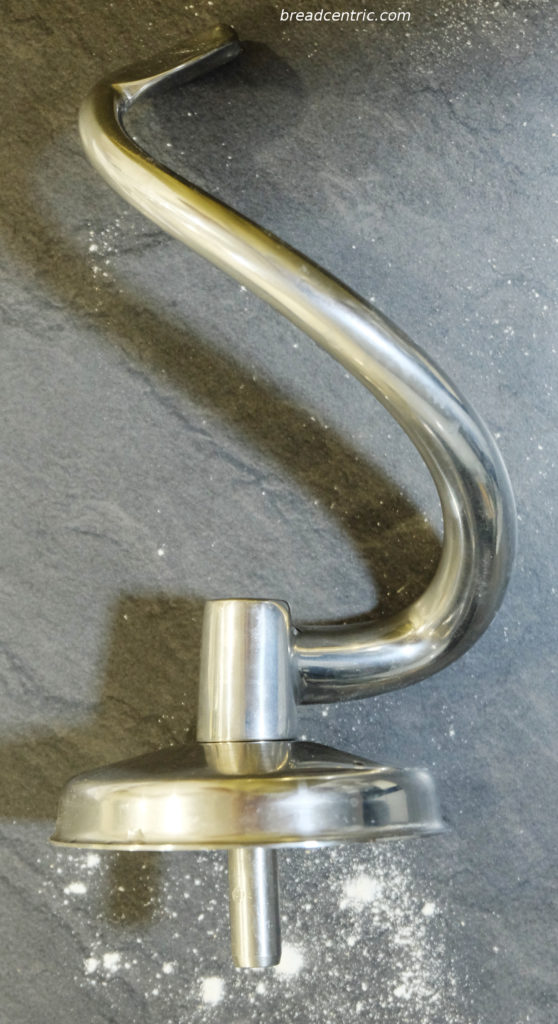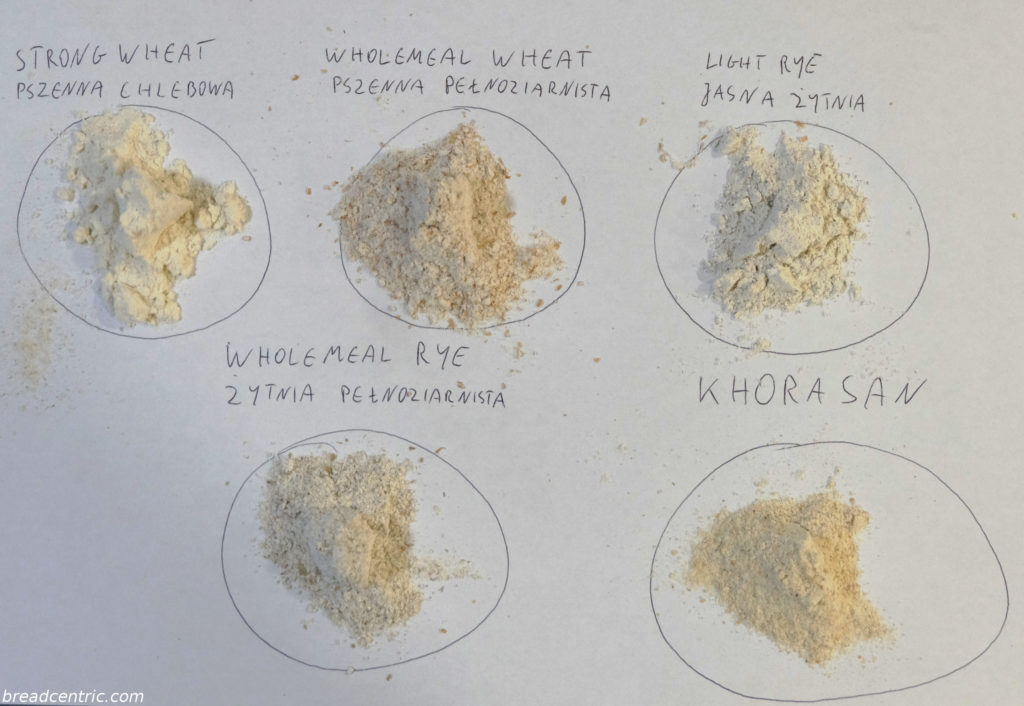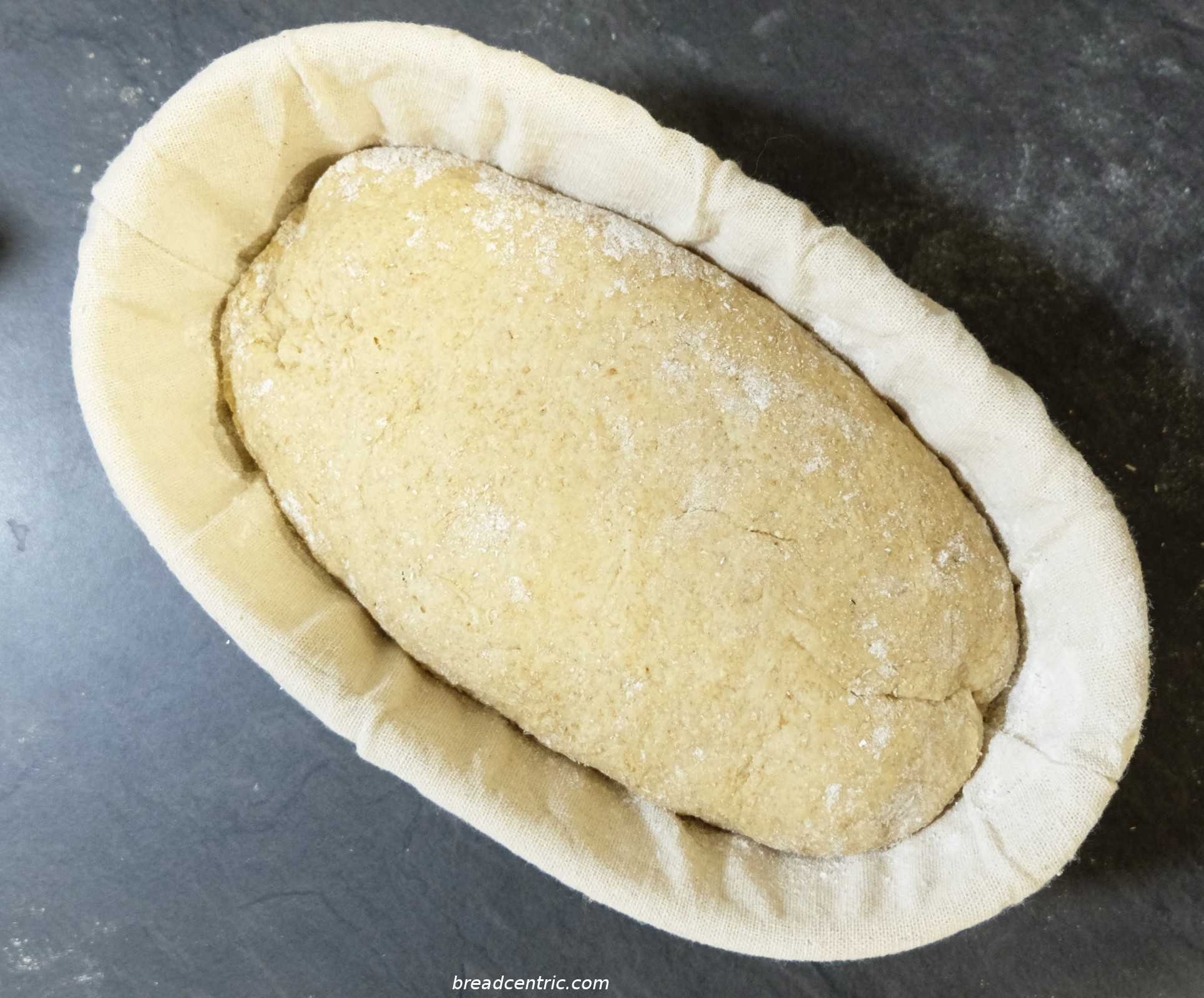Experimental day has come. I have reached back to ancient land of Khorasan, currently located in Iran and Afghanistan. See how it turned out.
Nadszedł dzień eksperymentów. Sięgnąłem wstecz, do starożytnej krainy Khorasan, obecnie zlokalizowanej w Iranie i Afganistanie. Zobacz jak wyszło.
Why Khorasan wheat? Because I was looking for some weird stuff to put into a bread and this guy popped up. I have heard about ancient grains but never had a chance to try them before. When I was looking for stuff on Shipton Mill’s website, I found this on offer and got a bag. And almost forgot about it. Recently I was looking through the flour cabinet and found it. Yes, we have a flour cabinet in our kitchen – we order a lot of flour, it needs to fit somewhere. Anyway – I found it and decided to use it.
It also made perfect sense to try out new bannetons and a spiral dough hook. You know, big boys and their toys. The hook requires a bit of a special handling – I had to start with less water and wait for the machine to knead the dough at first. Then I was gradually adding more and more water.

I’ve had no contact with Khorasan wheat flour before. It has an interesting smell, when grabbed between the fingers, it feels like finely ground breadcrumbs. It soaks a lot of water, the recipe calls for 75% hydration, but I went with 72% instead as it already felt quite well hydrated. I think the flour I got was wholemeal (the packaging did not state), but it did feel different in my hands to other flours listed below.

If I were to compare the dough, I’d say it was a noticeably more loose than wheat, but much easier to manage than the clay-like rye. One could clearly see the gluten structure, but it was quite easy to tear it, so I focused on folding and pressing against the worktop rather than stretching.
I used a quick recipe from Doves Farm website. The result was a bit dry, but satisfyingly filling and tasty.
Planning
None. I started at 7:30 pm and finished at 10 pm. An hour bulk proof, half an hour final proof, half an hour baking. Remember to knock at the bottom to hear hollow sound before removing from the oven.
I used a banneton to proof the dough, but you can use a colander with a clean tea towel dusted with rye flour (it sticks less).
Ingredients
This makes a single loaf weighing 800 grams.
- 500 g Khorasan whole wheat flour
- 360-375 g water
- 10 g salt
- 5 g sugar (could be ignored)
- 4 g dry yeast
Preparation
- Mix the dry ingredients in the bowl
- Gradually add water and mix until you get a dough with all ingredients incorporated
- Leave it for an hour to double in size. Remember: in the hot days it may take much less, in the cold days much longer
- Turn the oven on and set it to 200 C with a fan, 220 C without (recommended). Know your oven
- Take the dough onto a lightly floured surface and give it a couple folds. Be rather gentle – it’s not a classic wheat dough
- Shape the dough and put it into a banneton for 25-35 minutes. Note it will rise faster than the first time

Khorasan wheat bread in a banneton - Pop it into the oven, add steam and bake for about 35 minutes. When knocking on the bottom, it should give a hollow sound
- Leave it on a cooling rack

Khorasan wheat bread
My oven is usually forming the crust quickly and that’s what I experienced this time as I did not put a baking tray above it to shield it a bit. Still, it was nice and crunchy. Potentially this could have made the loaf more dense than it could be.
I overproofed it during the final rise, but not by much and it gave a bit of an oven spring with very few small unplanned cracks.

The crumb is rather dense and a bit dry – I wouldn’t have it by itself, without a butter at least. The taste is quite peculiar. Trying to find something to compare, I’d say it’s like a mixture of wheat, something like a corn flour and a bit of spinach – but this aroma was released after a couple minutes only. I had it with a horseradish soft cheese and smoked ham. Beautiful.
Now that I have the other half of the bag left, I am thinking of combining it with rye – I’ve seen a recipe for that on Bread Experience website. Or maybe I will combine it with barley and make a loaf as they used to make it in Pompei?
Czemu pszenica Khorasan? Bo szukałem czegoś niestandardowego do chleba i to mi się pokazało. Słyszałem już o starożytnych zbożach, ale nigdy nie miałem okazji ich wypróbować. Szukałem produktów na stronie Shipton Mill, znalazłem to i zamówiłem torebkę. I prawie całkiem o niej zapomniałem. Ostatnio przeglądałem szafkę mączną i i odnalazłem ją. Tak, mamy w kuchni osobną szafkę na mąkę – zamawiany sporo mąki i gdzieś ją musimy pomieścić. W każdym razie – znalazłem tę mąkę i postanowiłem jej użyć.
Była to też okazja, aby wypróbować nowe kosze do wyrastania i spiralny jak do ciasta. Wiecie, duzi chłopcy i ich zabawki. Hak wymaga trochę specyficznego podejścia – musiałem zacząć mieszać z mniejszą ilością wody, a dopiero po uzyskaniu gęstego ciasta zacząć dodawać resztę.

Wcześniej nie miałem do czynienia z pszenicą Khorasan. Na interesujący zapach, w dotyku jest trochę jak drobna bułka tarta. Wchłania dużo wody, w przepisie była hydracja 75%, ale mi wydało się to zbyt dużo i poprzestałem na 72%. Wydaje mi się, że ta mąka była pełnoziarnista (nie było podane na opakowaniu), ale nie jestem pewien, bo w dotyku jest całkiem inna niż znane mi mąki.

Jeśli miałbym do czegoś porównać ciasto, powiedziałbym, że jest zauważalnie luźniejsze niż pszenne, ale też bardziej elastyczne niż żytnie. Dało się dostrzec działanie glutenu, ale łatwo było go rozerwać, więc zamiast rozciągać i składać, raczej rozpłaszczałem je na blacie i składałem.
Przepis pochodzi ze strony Doves Farm. Chleb z niego był nieco suchy, ale satysfakcjonująco i sycący i smaczny.
Planowanie
Brak. Zacząłem o 19:30 i skończyłem o 22. Godzina pierwszego wyrastania, pół godziny końcowego wyrastania, pół godziny pieczenia. Pamiętaj sprawdzić, czy chleb dobrze się upiekł – powinien przy pukaniu wydawać głuchy odgłos.
Ja wyrastałem ciasto w koszu, ale możesz użyć durszlaka i oprószonej mąką ściereczki kuchennej. Do oprószenia użyj mąki żytniej – mniej się klei.
Składniki
Wystarczy na jeden bochenek 800 g.
- 500 g mąki pełnoziarnistej z pszenicy Khorasan
- 360-375 g wody
- 10 g soli
- 5 g cukru (można pominąć)
- 4 g suchych drożdży
Przygotowanie
- Zmieszaj suche składniki w misce
- Stopniowo dodawaj wodę, aż do uzyskania ciasta ze wszystkimi składnikami dobrze połączonymi ze sobą
- Pozostaw na godzinę do podwojenia objętości. Pamiętaj: w gorące dni zajmie mniej, w zimne – więcej
- Nastaw piekarnik na 200 stopni z termoobiegiem, 220 stopni bez termoobiegu (zalecane). Znaj swój piekarnik
- Wyjmij ciasto na oprószoną mąką powierzchnię i złóż kilka razy. Rób to raczej delikatnie – to nie jest standardowe ciasto pszenne
- Uformuj bochenek i umieść w koszu na 25-35 minut. Pamiętaj – będzie wyrastać szybciej niż za pierwszym razem

Chleb z pszenicy Khorasan w koszu do wyrastania - Włóż do piekarnika, zaparuj i piecz przez około 35 minut. Kiedy stukniesz w spód, powinien wydać głuchy odgłos
- Pozostaw na kratce do ostygnięcia

Chleb z pszenicy Khorasan
Mój piekarnik zazwyczaj szybko wypieka skórkę i tak było w tym przypadku – zapomniałem osłonić chleb od grzałki. Mimo to był ładny i chrupiący. Możliwe, że gdybym go osłonił, bochenek byłby trochę większy i lżejszy.
Trochę przerosłem ciasto podczas końcowego wyrastania. Ale nie za wiele – wciąż trochę go podniosło i miał kilka małych nadprogramowych pęknięć.

Miękisz był raczej gęsty i troszkę suchy – samym chlebem bez masła raczej bym się nie zajadał. Smak jest osobliwy. Gdybym miał go do czegoś porównać, powiedziałbym, że to trochę jak mieszanka mąki pszennej z chyba kukurydzianą i odrobiną szpinaku – ten aromat uwalnia się po kilku minutach szukania. Chleb zjadłem z serkiem śniadaniowym z chrzanem i wędzoną szynką. Coś pięknego.
Teraz zostało mi pół worka i myślę połączyć je z żytem – na stronie Bread Experience widziałem taki przepis. A może połączę z jęczmieniem i spróbuję zrobić chleb jak w Pompejach?
